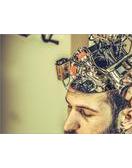When you think life has settled in it chooses to get in your face, passing by at a crazy pace. Before his pacemaker placement, Gary’s heart rate was consistently slowing, as low as 29 bpm, with swings upward topping 220+ bpm. Accompanied by more than his usual dizziness, and a burning sensation in his chest the danger of a heart attack or stroke was high.
Gary had no prior history of heart disease, no plaque build-up, blockages, or weak valves. His is strictly an electrical problem. His pacemaker is now handling the low end nicely, but his heart continues to race. He has now been diagnosed with Sick Sinus Syndrome (SSS) that has developed into Tachy-Brady Syndrome.
Sick Sinus Syndrome (SSS), is a grouping of cardiac arrhythmias that present as an abnormal sinus node impulse which causes are categorized as either intrinsic or extrinsic. Gary’s problem is thought to be extrinsic since he displays signs of autonomic nervous system dysfunction. Are Gary’s heart problems superficial siderosis related? We know he experiences autonomic nerve problems, so the answer is maybe? Probably? It’s still very much a gray area as far as his cardiologist is concerned.
The vagus nerve (10th cranial) begins in your brain stem traveling in branches all the way to your colon. It’s responsible for controlling your heart rate via electrical impulses to specific muscle tissue. This nerve is your heart’s natural pacemaker. Besides your heart and lungs, your vagus nerve supplies the fibers to your throat, larynx, esophagus, and a good portion of your colon. The vagus also brings sensory information back from your ears, tongue, throat, and larynx.
An early indicator of hemosiderin deposits on your brain stem is affecting your vagus nerve? Your voice becomes hoarse or nasal. Your esophagus may have trouble with natural movement, or your vocal cords may stop working. As damage progresses to this group of nerve fibers, the result is dysphagia and dysphonia (trouble swallowing and trouble speaking). Motility problems from the colon turn into a constant cycle of constipation and diarrhea.
Gary has suffered colon related motility problems for years. He is under the care of a speech and swallows specialist for oropharyngeal dysphagia. We travel this week to see an ENT Gary was referred to because during his last dysphagia check the doctor noticed a change in his voice. It is now hoarse all the time. His next dysphagia check is scheduled to include a barium check of his esophagus.
No doctor is willing to say “Yes, the heart problems are from superficial siderosis” but I have to say the evidence is compelling. His cardiac team is now trying to balance multiple medications to control the high heart rate.
During the chaos of tri-weekly doctor appointments, we also had to find time to remodel of our storage room into a nursery. The restrictions of his pacemaker recovery completely sidelined Gary. He was forced to watch the whole thing, and it drove him crazy. Our neighbors jumped in to help. Remodeling used to be easy but not so much now. I’m happy to report we finished in time to welcome our first great-granddaughter into our lives. Harper Leigh has arrived so let chaos reign.

